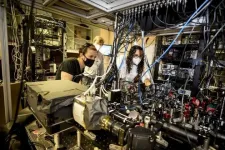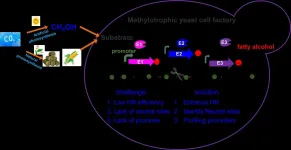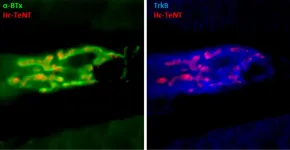(Press-News.org) Coral reefs are a favorite spot for scuba divers and are among the world's most diverse ecosystems. For example, the Hawaiian coral reefs, known as the "rainforests of the sea," host over 7,000 species of marine animals, fishes, birds and plants. But coral reefs are facing serious threats, including a number of diseases that have been linked to human activity.
To understand the connection between human activity and a type of tumorlike disease called growth anomalies (GAs), researchers at the National Institute of Standards and Technology (NIST) have collaborated with the U.S Geological Survey (USGS) and the National Oceanic and Atmospheric Administration (NOAA) to use an emerging molecular profiling method to identify 18 small molecules that promise to help them better understand the series of molecular reactions that lead to the disease.
GAs affect both the coral skeleton and its soft tissues. Scientists don't know the cause of the disease or how it spreads but have hypothesized that there is a strong correlation between GA prevalence in coral colonies and human population density nearby.
Almost all types of corals are made of hundreds to millions of individual soft-bodied animals called polyps. The polyps secrete calcium carbonate to form a hard skeleton that lays the foundation for the coral colony. GAs affect corals through irregular and accelerated growth of their skeleton, causing it to be less dense and filled with holes. This results in a tumorlike mass in the skeleton of a coral colony with fewer polyps and a diminished ability to reproduce.
Shallow water corals receive food like carbohydrates and oxygen as a byproduct of photosynthesis from the symbiotic relationship they have with zooxanthellae, photosynthetic algae that live inside coral tissues. GAs can lead to fewer symbiotic zooxanthellae and therefore less energy being absorbed from photosynthesis.
Even though GAs do not typically directly lead to coral death, they do affect the overall health of coral colonies and can pose an ecological threat to coral populations. To analyze the disease, NIST researchers chose the coral species Porites compressa as their target sample.
This coral species is known as the "finger" or "hump" coral and is part of the stony coral family, which is "one of the important reef-building species in Hawaii," said NIST chemist Tracey Schock. "They lay the foundation for the coral reef."
P. compressa is found in shallow lagoons off the Hawaiian Islands, and the researchers obtained their coral samples from Kaneohe Bay, Oahu. The bay has been studied widely as a site affected by human activity such as sewage discharge and metal pollution. GAs have previously been observed in the coral species there.
In order to analyze and study GAs in P. compressa, researchers turned to the field of metabolomics, which is the study of small molecules, such as those making up living organisms found in tissues, blood or urine. These small molecules, known as metabolites, are the intermediate and end products in a linked series of biochemical reactions known as molecular pathways in an organism.
Some examples of such small molecules include sugars like glucose, amino acids, lipids and fatty acids. Their production can be influenced by genetic and environmental factors and can help researchers better understand the biochemical activity of tissue or cells. In this case, chemical analysis of metabolites provides significant information that helps researchers understand the physiology of the disease.
For their study, researchers sampled a coral colony that had both healthy and diseased tissue. They split up their samples so they could assess the healthy coral and diseased coral separately. They also had a separate adjacent sample that was free of diseased tissue.
The samples were frozen in liquid nitrogen, and then freeze-dried for practical sample processing while maintaining metabolic integrity. The researchers then separated the diseased parts from the healthy colony using a hammer and stainless-steel chisel and collected the tissue from the skeleton with a brush. In one of the final stages of the sample preparation, they chemically extracted the metabolites from the coral tissue using a combination of methanol, water and chloroform.
"The method is novel for coral studies," said Schock. "With metabolomics, it is critical to preserve the state of all metabolites in a sample at the time of collection. This requires halting all biochemical activity using liquid nitrogen and maintaining this state until chemical extraction of the metabolome. The complexity of a coral structure necessitates stringent collection and processing protocols."
The researchers then produced a metabolomic analysis of the coral samples by using a reproducible profiling technique known as proton nuclear magnetic resonance (1H NMR).
The 1H NMR technique exposes the coral extract to electromagnetic fields and measures the radio frequency signals released by the hydrogens in the sample. The various kinds of metabolites are revealed by their unique signals which inform of their chemical environment. NMR detects all signals from the magnetic nuclei within a sample, making it an unbiased "all-in-one" technique. Two-dimensional NMR experiments that can identify both hydrogens (1H) and their directly bound carbon (13C) atoms provide more chemical information, giving confidence in the accuracy of the identities of the various metabolites within a sample.
The study identified 18 different metabolites and a new GA morphological form in P. compressa. The researchers found that GA tumors have distinct metabolite profiles compared with healthy areas of the same coral colony and detected specific metabolites and metabolic pathways that may be important for these profile differences. They also discovered that the loss of internal pH regulation is seemingly responsible for the hollow skeletons that are a characteristic of GAs.
"We have not only characterized new aspects of GA physiology, but have also discovered candidate pathways that provide a clear path forward for future research efforts aiming to further understand GA formation and coral metabolism, in general," said Schock.
As studies of this type accumulate, the researchers envision a database that could pull together coral metabolite information from multiple coral species into an accessible location for all scientists.
Collaborating with other researchers in different fields could increase understanding of the biological impacts of this disease on coral colonies. "We are going to learn which species are tolerant and which species are sensitive to stresses, and the physiological adaptations or mechanisms of both types will be important to conservation efforts," said Schock.
For now, the researchers hope these findings will be helpful for other scientists analyzing coral species and ultimately be beneficial for the coral reefs themselves, potentially aiding efforts to better preserve them.
INFORMATION:
ATLANTA--The American College of Rheumatology (ACR), in partnership with the Vasculitis Foundation (VF), released three new guidelines for the treatment and management of systemic vasculitis. Vasculitis is a group of about 20 rare diseases that have inflammation of blood vessels in common, which can restrict blood flow and damage vital organs. The three guidelines cover six forms of vasculitis, and a fourth guideline on Kawasaki disease will be released in the coming weeks.
"Many rheumatologists may have limited experience caring for patients with these diseases," ...
Strokes, which occur when the blood supply to part of our brain is interrupted or reduced, are the leading cause of death and disability in the adult population. Among the patients who survive, 75% will experience difficulties carrying out daily activities independently and need long-term functional exercises and rehabilitation. But the outcomes using traditional rehabilitation equipment are poor. In addition, the motivation of patients to train is often low.
The Department of Neurology in Tongji Hospital, which is affiliated to Tongji Medical College at the Huazhong University of Science and Technology, is recognised in China for the quality of its scientific research and clinical strength. Similarly, Zhejiang BrainCo, Ltd., incubated by the Harvard Innovation Lab, is a market ...
Contrary to conventional thought, songbirds can taste sugar--even though songbirds are the descendants of meat-eating dinosaurs and are missing a key protein that allows humans and many other animals to taste sweetness. An international team investigated how many bird species can taste sweet and how far back that ability evolved. Their work was published today in the journal Science.
The researchers offered two species of songbirds a choice between sugar water and plain water--nectar-taking honeyeaters, as well as canaries, a grain-eating bird not known for consuming sweet foods. They also examined taste receptor responses sampled from a variety of other species. Regardless of whether their main ...
A team of physicists from the Harvard-MIT Center for Ultracold Atoms and other universities has developed a special type of quantum computer known as a programmable quantum simulator capable of operating with 256 quantum bits, or "qubits."
The system marks a major step toward building large-scale quantum machines that could be used to shed light on a host of complex quantum processes and eventually help bring about real-world breakthroughs in material science, communication technologies, finance, and many other fields, overcoming research hurdles that are beyond the capabilities of even the fastest supercomputers today. Qubits are the fundamental building blocks on which quantum computers ...
How does unicellular life transition to multicellular life? The research team of Professor Lutz Becks at the Limnological Institute of the University of Konstanz has taken a major step forward in explaining this very complex process. They were able to demonstrate - in collaboration with a colleague from the Alfred Wegner Institute (AWI) - that the unicellular green algae Chlamydomonas reinhardtii, over only 500 generations, develops mutations that provide the first step towards multicellular life. This experimentally confirmed a theory on the origin of multicellular life, which says that the evolution of cell groups and the subsequent steps towards multicellularity can only take place when cell groups are both better at reproduction and more likely to survive than single cells. ...
Although the giant panda is in practice a herbivore, its masticatory system functions differently from the other herbivores. Through the processes of natural selection, the giant panda's dietary preference has strongly impacted the evolution of its teeth and jaws. Researchers from the Institute of Dentistry at the University of Turku and the Biodiversity unit of the University of Turku together with researchers from the China Conservation and Research Center for Giant Panda (CCRCGP) have been the first in the world to solve the mystery of how the giant panda's special stomatognathic system functions.
The bamboo diet of the giant panda (Ailuropoda melanoleuca) has long been a ...
Pichia pastoris (syn. Komagataella phaffii), a model methylotrophic yeast, can easily achieve high density fermentation, and thus is considered as a promising chassis cell for efficient methanol biotransformation. However, inefficient gene editing and lack of synthetic biology tools hinder its metabolic engineering toward industrial application.
Recently, a research group led by Prof. ZHOU Yongjin from the Dalian Institute of Chemical Physics (DICP) of the Chinese Academy of Sciences established an efficient genetic engineering platform in Pichia pastoris.
The study was published in Nucleic Acids Research on July 1.
The researchers developed ...
Depression has been treated traditionally with inhibitors of serotonin reuptake in the central nervous system. These drugs do not come without side effects, such as lack of immediate therapeutic action, the need for daily doses and the danger of becoming addicted to some of these drugs. That is why scientists continue to work on new therapies to treat depression.
In 2019, an international group of researchers co-led by Dr Yousef Tizabe from the Howard University College of Medicine in Washington, D.C., and Professor José Aguilera from the Department of Biochemistry and Molecular Biology and the Institut de Neurociències ...
To splice or not to splice...
In an article published in the journal RNA, Karan Bedi, a bioinformatician in Mats Ljungman's lab, Department of Radiation Oncology at the University of Michigan Medical School, investigated the efficiency of splicing across different human cell types. The results were surprising in that the splicing process appears to be quite inefficient, leaving most intronic sequences untouched as the transcripts are being synthesized. The study also reports variable patterns between the different introns within a gene and across cell lines, and it further highlights ...
Researchers at the University of Freiburg and the University of Stuttgart have developed a new process for producing movable, self-adjusting materials systems with standard 3D-printers. These systems can undergo complex shape changes, contracting and expanding under the influence of moisture in a pre-programmed manner. The scientists modeled their development based on the movement mechanisms of the climbing plant known as the air potato (Dioscorea bulbifera). With their new method, the team has produced its first prototype: a forearm brace that adapts to the wearer and which can be further developed for medical applications. ...







